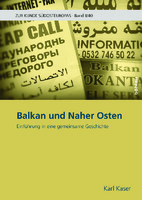Balkan und Naher Osten
Einführung in eine gemeinsame Geschichte
| dc.contributor.author | Kaser, Karl | |
| dc.date.accessioned | 2013-12-31 23:55:55 | |
| dc.date.accessioned | 2020-01-09 15:43:01 | |
| dc.date.accessioned | 2020-04-01T15:12:12Z | |
| dc.date.available | 2020-04-01T15:12:12Z | |
| dc.date.issued | 2011 | |
| dc.identifier | 437205 | |
| dc.identifier | OCN: 952493245 | en_US |
| dc.identifier.uri | http://library.oapen.org/handle/20.500.12657/34374 | |
| dc.description.abstract | The Balkans and the Near East share millennia of a shared history, which stretches from sedentarization in early history to the 20th century. In the Neolithic period, in Mesopotamia and in the Balkans basic techniques and skills were developed on which Europe and the Islamic world could be based later on. Thus, for example, in the centres of "Ancient Europe" - in the middle basin of the Danube River - already in the 5th millennium people experimented with early script systems, long before the first cuneiform texts in Mesopotamia and the hieroglyph texts in ancient Egypt became in use. The "division of labour" between the various scholarly disciplines in the fields of Balkan studies and Near (Middle) East studies resulted in the separation of a shared history into a Southeast European or Balkan history on the one hand and a history of the Near (Middle) East on the other hand. It is therefore the aim of the monograph to unite the separated histories to a joint one. Since this cannot be done by the simple operation of adding up two histories, the volume opens new perspectives. A comparable historiographical piece of work does not yet exist. The geographical space covered by the text extends between Bosnia in the west, the Iraq in the east and the Arabic Peninsula and Egypt in the south. The composition of the material is based on regional and temporal comparison. Specifically, temporal comparison constitutes a great challenge, because approximately 10,000 years are covered. The book is organized by topics and comprises 17 chapters, 455 manuscript pages and approximately 120 graphs and photographs. Conceptualized as an introductory text, the book may also interest a wider public. The style of writing is generally intelligible and addresses for instance the burning contemporary tensions between Islam and Europe. In addition, topics such as history of religion, historical-anthropological, economic, cultural as well as questions of gender relations are addressed on a principal basis. | |
| dc.language | German | |
| dc.subject.classification | thema EDItEUR::N History and Archaeology::NH History | en_US |
| dc.subject.other | Balkans | |
| dc.subject.other | History | |
| dc.subject.other | Near East | |
| dc.subject.other | Religion | |
| dc.subject.other | Gender | |
| dc.subject.other | Historical Anthrolpology | |
| dc.subject.other | Osmanisches Reich | |
| dc.title | Balkan und Naher Osten | |
| dc.title.alternative | Einführung in eine gemeinsame Geschichte | |
| dc.type | book | |
| oapen.abstract.otherlanguage | Der Balkan und der Nahe Osten teilen eine Tausende von Jahren währende gemeinsame Geschichte, die von der Sesshaftwerdung in der Frühgeschichte bis in das 20. Jahrhundert reicht. In Mesopotamien und auf dem Balkan wurden in der Jungsteinzeit jene Techniken und Fertigkeiten entwickelt, auf denen später Europa und die islamische Welt aufbauen konnten. So wurde beispielsweise in den Zentren "Alteuropas" - entlang der mittleren Donau - ab dem 5. Jahrtausend bereits mit frühen Schriftsystemen experimentiert, ehe die ersten Keilschrifttexte in Mesopotamien und die Hieroglyphenschrift Ägyptens entwickelt werden sollte. Die "Arbeitsteilung" zwischen einzelnen Wissenschaftsdisziplinen hat es mit sich gebracht, dass diese gemeinsame Geschichte immer wieder aufs Neue gesondert geschrieben wurde: einerseits als Geschichte des Balkans oder des südöstlichen Europa, andererseits als Geschichte des Nahen Ostens. Das zur Publikation anstehende Buch hat das Ziel, diese gesondert betrachteten Geschichten zu einer gemeinsamen zusammenzuführen und entwirft somit eine völlig neue Perspektive. Eine vergleichbar konzipierte Darstellung wurde noch nicht unternommen. Geografisch gesehen erstreckt sich die Darstellung zwischen Bosnien im Westen, dem Irak im Osten und der Arabischen Halbinsel und Ägypten im Süden. Die Darstellung des Stoffes ist auf regionalen und temporalen Vergleichen aufgebaut. Insbesondere der temporale Vergleich stellt eine Herausforderung dar, weil der Zeitraum ca. 10000 Jahre umfasst. Das nach Themenbereichen geordnete Buch ist in 17 Kapitel gegliedert und umfasst 455 Manuskriptseiten mit rund 120 Abbildungen. Als eine Einführung für Studierende konzipiert, kann das Werk auch ein allgemein interessiertes Publikum ansprechen. Der Text ist allgemein-verständlich gehalten und geht insbesondere auch auf das gegenwärtige Spannungsverhältnis zwischen dem Islam und Europa ein. Des Weiteren werden religionsgeschichtliche, historisch-anthropologische, ökonomische, kulturelle wie auch Fragen der Geschlechtergeschichte grundsätzlich beleuchtet. | |
| oapen.identifier.doi | 10.26530/oapen_437205 | |
| oapen.relation.isPublishedBy | af16fd4b-42a1-46ed-82e8-c5e880252520 | * |
| oapen.relation.isFundedBy | 26ae1657-c58f-4f1d-a392-585ee75c293e | |
| oapen.collection | Austrian Science Fund (FWF) | |
| oapen.imprint | Böhlau | |
| oapen.pages | 474 | |
| oapen.grant.number | D 4206 | |
| oapen.remark.public | Relevant Wikipedia page: Osmanisches Reich - https://de.wikipedia.org/wiki/Osmanisches_Reich | |
| oapen.identifier.ocn | 952493245 |

